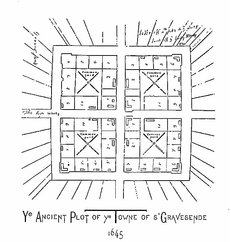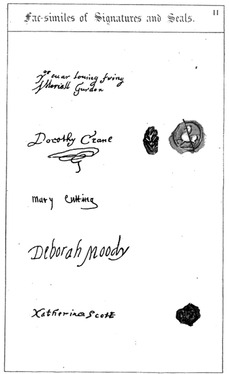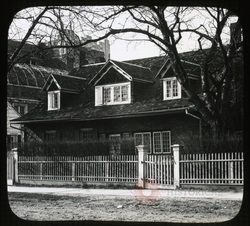
The architecture alone might deem the building worthy enough to preserve it. At times though enough significance to preserve a building is leant to it by a former resident’s contribution to society. Lady Deborah Moody, a 17th century Englishwoman, was significant in the development of the town of Gravesend, Brooklyn and some historical accounts claim that she built and was the first resident of 27 Gravesend Neck Road. But was she?
 Deborah Moody facsimile signature on letter to John WInthrop, Jr. c.1649
Deborah Moody facsimile signature on letter to John WInthrop, Jr. c.1649 Lady Deborah Moody was a nonconformist who fled England in the mid-17th century in search of liberty of conscience and freedom from Parliament. The exact date of her departure is unknown, but a book written in 1880 by James Watson Gerard, Lady Deborah Moody: A Discourse Delivered Before the New York Historical Society, places her arrival in America, Massachusetts Bay Colony, sometime before 1640. Moody was not an ordinary immigrant. She had come from a family of power and means. Her father, Walter Dunch, was a Member of Parliament during Queen Elizabeth’s time and her uncle a member during the reigns of James the First and Charles the First. Five years before Moody’s departure from England, she removed herself from the center of London where there was much political controversy over the desire of Charles the First to unite England, Scotland, and Ireland into a single kingdom. She was ordered to return since the law required that no woman was to be absent from her “herediments” (i.e., home) for more than 40 days. Instead, she chose to leave the country. As a widow, she left her children in England and exiled herself.
FROM MASSACHUSETTS TO NEW YORK
By 1643, Moody had settled in Salem, Massachusetts. We know this because a record of the town indicated that she was excommunicated from the church in Salem because of her belief against infant baptism. Not about to change her belief, she removed to Brooklyn against the counsel of her friends. There she continued in her stalwart independent spirit of freedom of religious beliefs and became a leader in the area. While she experienced much trouble from Native Americans assailing her home, her wealth enabled her to obtain the assistance of the current Director-General of the colony of New Netherland, Peter Stuyvesant. Her influence grew as she was given the power, in part, to nominate magistrates. In the 1909 Historical Guide to the City of New York she is also credited with entertaining Stuyvesant and the previous Director, Willem Kieft in her home, which was later used as a hospital during the Revolutionary War. But are these just stories surrounding the building which hangs in the balance of being preserved?
 Hicks-Platt House (Brooklyn Historical Society)
Hicks-Platt House (Brooklyn Historical Society) While the stories of what occurred in the home at 27 Gravesend might be true, there are some documents which bring into doubt who the builder of the house truly was. The house, dubbed “Lady Moody House,” was given several names in the 1918 edition of Documents of the Assembly of the State of New York, including the “Van Siclen [sic] house,” and the “Hicks-Platt house.” The AIA Guide to New York City notes that a real estate developer, William E. Platt, in 1890 publicized the house as “Lady Moody’s own home” supposedly beginning the rumor which continued throughout the following decades.
The 1918 Annual Report of the American Scenic and Historic Preservation Society claims that the Van Siclen [sic] house, located on the corner of Gravesend Avenue and Neck Road, is erroneously called the Lady Deborah Moody’s house. The house was built before the American Revolution, which provides architectural significance; however, in the report a man by the name of Mr. W. B. Lake was said to have accurately located the site of Lady Deborah Moody’s house “on the northeast corner of the town stockade” which, if true, would mean that Lady Moody never resided at 27 Gravesend Neck Road.
The 1918 report however, cannot be counted as conclusive because contradictory reports also exist. Converse to the 1918 report, in a 1932 article in The Brooklyn Daily Eagle, the owner of the home at 27 Gravesend, Annie M. Anderson, claimed to have researched the home back to its origins which included Lady Deborah Moody. And yet, in this same article, the president of the Kings County Historical Society, Charles A. Ditmas, claims to doubt the building is that old (1643). Instead, he states that the home was constructed by the Van Sicklen family shortly after 1700.
There is no doubt that searching the property deeds and origins of this house was difficult and subject to more errors in those early years because of the lack of accessible records. Today that is less of a problem. Along with online information, digitization of records, and the awareness of our need to discover accurate historical property information, more records are becoming available. While the answer to the question is discoverable, it is simply waiting for someone who can fund the quest.
Contact us to request further research on this building.
 RSS Feed
RSS Feed